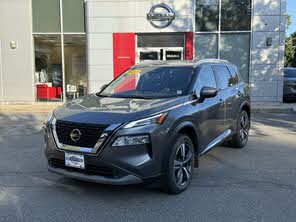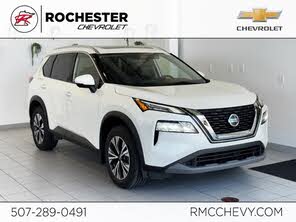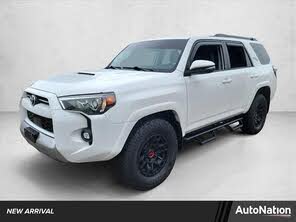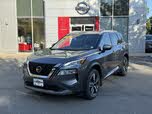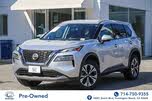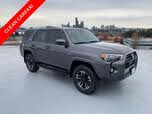2021 Nissan Rogue vs 2022 Toyota 4Runner
Overview | |
MSRP$26,050 | MSRP$38,105 |
Listings2468 | Listings1609 |
Ratings & Reviews | |
User Reviews | User Reviews |
Expert reviews9.0 out of 10 | Expert reviews7.0 out of 10 |
Pros
Cons
| Pros
Cons
|
2021 Nissan Rogue Reviews SummaryTo characterize the all-new 2021 Nissan Rogue as vital to the automaker's success is an understatement. Not only is the compact crossover SUV the best-selling Nissan in America, but it's also one of the best-selling vehicles in America. Strip out pickup trucks, and the Rogue sits near the top of the U.S. sales chart with its primary competitors, the Honda CR-V and Toyota RAV4. Imagine the pressure on Nissan designers, engineers, and product planners as they prepared the current Rogue's replacement! The good news is that the new Rogue is a better SUV in every way but one. | |
2022 Toyota 4Runner Reviews SummaryFamily-hauling, kid-toting three-row SUVs have become the de facto vehicle in most suburban towns. Just look in any mall parking lot, and you’re bound to see countless Honda Pilots and Toyota Highlanders. So ubiquitous are these vehicles, you might forget that the definition of “Sport Utility Vehicle” is actually quite vast, and there are still new examples that have some connection to the segment’s rugged origins. The 2022 Toyota 4Runner is one such example. It may not be optimized for soccer practice or pizza-party duties, but it can certainly handle them. Just as crucially, it can also venture out where these mall-dwelling SUVs dare not go. If two years of a pandemic have taught us anything about ourselves, it's that the ability to get out on an adventure is more relevant than ever, and the 4Runner is one vehicle so-equipped to do it. | |
Popular Features & Specs | |
Engine2.5L 181 hp I4 | Engine4.0L 270 hp V6 |
Drive TrainFWD | Drive Train4X2 |
Seating Capacity5 | Seating Capacity7 |
Horsepower181 hp @ 6000 rpm | Horsepower270 hp @ 5600 rpm |
MPG City27 | MPG City16 |
MPG Highway35 | MPG Highway19 |
Engine | |
Engine Name2.5L 181 hp I4 | Engine Name4.0L 270 hp V6 |
Torque181 lb-ft @ 3600 rpm | Torque278 lb-ft @ 4400 rpm |
Horsepower181 hp @ 6000 rpm | Horsepower270 hp @ 5600 rpm |
DrivetrainFWD | Drivetrain4X2 |
Fuel Economy | |
MPG City27 | MPG City16 |
MPG Highway35 | MPG Highway19 |
Interior | |
Seating Capacity5 | Seating Capacity7 |
Safety | |
Front Crash Overall3 | Front Crash Overall4 |
Side Crash Overall5 | Side Crash Overall5 |
Dimensions & Capacity | |
Cargo Space31.6 cu ft | Cargo Space47.2 cu ft |
Curb Weight3371 lbs | Curb Weight4400 lbs |
Height66.5 in | Height71.5 in |
Length183.0 in | Length190.2 in |
Width72.4 in | Width75.8 in |
Wheelbase106.5 in | Wheelbase109.8 in |
Maximum Payload1115 lbs | Maximum Payload1700 lbs |
Number of doors4 | Number of doors4 |
Maximum Towing Capacity | Maximum Towing Capacity5000 lbs |
Standard Towing Capacity | Standard Towing Capacity5000 lbs |
Overview | ||
MSRP | $26,050 | $38,105 |
Listings | ||
Ratings & Reviews | ||
User reviews | ||
Expert reviews | 9.0 out of 10Read full review | 7.0 out of 10Read full review |
Pros & cons | Pros
Cons
| Pros
Cons
|
Summary | To characterize the all-new 2021 Nissan Rogue as vital to the automaker's success is an understatement. Not only is the compact crossover SUV the best-selling Nissan in America, but it's also one of the best-selling vehicles in America. Strip out pickup trucks, and the Rogue sits near the top of the U.S. sales chart with its primary competitors, the Honda CR-V and Toyota RAV4. Imagine the pressure on Nissan designers, engineers, and product planners as they prepared the current Rogue's replacement! The good news is that the new Rogue is a better SUV in every way but one. | Family-hauling, kid-toting three-row SUVs have become the de facto vehicle in most suburban towns. Just look in any mall parking lot, and you’re bound to see countless Honda Pilots and Toyota Highlanders. So ubiquitous are these vehicles, you might forget that the definition of “Sport Utility Vehicle” is actually quite vast, and there are still new examples that have some connection to the segment’s rugged origins. The 2022 Toyota 4Runner is one such example. It may not be optimized for soccer practice or pizza-party duties, but it can certainly handle them. Just as crucially, it can also venture out where these mall-dwelling SUVs dare not go. If two years of a pandemic have taught us anything about ourselves, it's that the ability to get out on an adventure is more relevant than ever, and the 4Runner is one vehicle so-equipped to do it. |
Video | ||
Popular Features & Specs | ||
Engine | 2.5L 181 hp I4 | 4.0L 270 hp V6 |
Drive Train | FWD | 4X2 |
Seating Capacity | 5 | 7 |
Horsepower | 181 hp @ 6000 rpm | 270 hp @ 5600 rpm |
MPG City | 27 | 16 |
MPG Highway | 35 | 19 |
Engine | ||
Engine Name | 2.5L 181 hp I4 | 4.0L 270 hp V6 |
Torque | 181 lb-ft @ 3600 rpm | 278 lb-ft @ 4400 rpm |
Horsepower | 181 hp @ 6000 rpm | 270 hp @ 5600 rpm |
Drivetrain | FWD | 4X2 |
Fuel Economy | ||
MPG City | 27 | 16 |
MPG Highway | 35 | 19 |
Interior | ||
Seating Capacity | 5 | 7 |
Safety | ||
Front Crash Overall | 3 | 4 |
Side Crash Overall | 5 | 5 |
Dimensions & Capacity | ||
Cargo Space | 31.6 cu ft | 47.2 cu ft |
Curb Weight | 3371 lbs | 4400 lbs |
Height | 66.5 in | 71.5 in |
Length | 183.0 in | 190.2 in |
Width | 72.4 in | 75.8 in |
Wheelbase | 106.5 in | 109.8 in |
Maximum Payload | 1115 lbs | 1700 lbs |
Number of doors | 4 | 4 |
Maximum Towing Capacity | 5000 lbs | |
Standard Towing Capacity | 5000 lbs | |
In 2021, the Nissan Rogue wore handsome new styling with a more technical appearance, making it look more like an SUV than a car. The dark gray plastic cladding covering the Rogue's lower perimeter, along with bold, simulated skid plates and lower door protection, conveyed a rugged aura—though some felt that the audacious design on the SUV's back bumper was a bit overdone. Clean LED lighting elements, a prominent V-Motion grille, and well-proportioned dimensions lent the 2021 Rogue a modern aesthetic. All trim levels included aluminum wheels, sized up to 19 inches in diameter, and optional two-tone paint with a black roof treatment gave the SUV a custom look.
The 2021 Rogue offered four versions: S, SV, SL, and the new-for-2021 Platinum. These ranged in price from $25,650 for the base S, up to $35,430 for the Platinum, plus $1,095 in destination charges. Options included all-wheel drive for $1,400 and Premium packages for the SV and SL trims, priced at $2,660 and $1,320, respectively. The tested Rogue SL, with added Premium Package, extra-cost paint, floor mats, and a cargo area protection package, totaled $35,195, including destination charges.
The Rogue SL's interior featured an Almond color leather interior and a standard panoramic glass sunroof. This combination made the cabin light and bright, emphasizing its improved roominess. Soft-touch surfaces, appealing simulated wood trim, and fabric-wrapped windshield pillars lent a sense of quality to the interior. Nissan's controls arrangement was clean and logical. For a genuinely luxurious look and feel, the Platinum trim provided quilted semi-aniline leather, contrast stitching, and ambient lighting.
A quirky detail about the Rogue's interior was the retro appearance of the numbers on the climate control panel, reminiscent of a 1980s digital clock. Despite its nod to the past, the Rogue was technologically forward, offering features like wireless Apple CarPlay.
In contrast, the 2022 Toyota 4Runner retained its roots in the SUV craze of the 1980s, sticking to its rugged heritage linked to the Toyota Tacoma pickup. While most modern SUVs evolved to more car-based platforms, the 4Runner persisted with its rugged construction. This positioned it as a niche vehicle for off-road enthusiasts rather than a family hauler like the Toyota Highlander.
The 4Runner flaunted its adventurous spirit with a high ride height, boxy proportions, and a sharply angled front bumper designed to approach obstacles. Its interior, though functional, felt dated with a dash layout reminiscent of the late-2000s.
The 2022 4Runner was available in several trims: SR5, Trail Special Edition, TRD Sport, TRD Off-Road, TRD Pro, and Limited. The SR5 came standard with features like push-button start, remote keyless entry, a power-sliding rear window, satellite radio, multiple USB ports, a WiFi hotspot, and an 8-inch touchscreen infotainment system with Apple CarPlay and Android Auto.
The 4Runner SR5 Premium sub-trim added HD radio, heated front seats, synthetic leather upholstery, and power-adjustable front seats. The Trail Special Edition featured 17-inch dark gray alloy wheels, a unique monotone paint scheme, and off-road-oriented features.
In comparison, the TRD Sport offered road-oriented touches like 20-inch wheels and X-REAS performance suspension, while the TRD Off-Road focused on off-road capabilities with features like a locking rear differential, beefed-up skid plates, and a terrain management system.
The TRD Pro built on the TRD Off-Road Premium with enhanced shock absorbers, a 15-speaker JBL premium stereo system, and off-road cameras. The Limited trim focused on road comfort with features like heated and ventilated front seats, leather upholstery, and dual-zone automatic climate control.

















When it came to performance, the 2021 Nissan Rogue lagged slightly behind, largely due to its need for more power. It weighed in at nearly 3,500 pounds and was only equipped with a 2.5-liter four-cylinder engine producing 181 horsepower at 6,000 rpm and 181 pound-feet of torque at 3,600 rpm. This output was deemed adequate for typical daily driving, and the continuously variable transmission (CVT) did a decent job of optimizing available torque. The CVT was smooth and less intrusive than most, aided by programmed ratios that helped it feel more like a traditional automatic. Paddle shifters were available on the steering wheel, but they were rarely used.
For off-road adventures, the Rogue was better equipped with available all-wheel drive (AWD), up to 8.2 inches of ground clearance, and new Snow and Off-Road driving modes. Nissan hinted at a future turbocharged option but offered no firm commitments. Meanwhile, different driving modes like Sport and Eco allowed for customized driving experiences. The tested Rogue SL with front-wheel drive managed 27.5 mpg on varied terrains, which was 1.5 mpg short of the official EPA rating.
The 2021 Rogue's impressive ride and handling stemmed from a new architecture composed of 35% high-strength steel, providing robust support. The suspension setup included a strut front and multi-link rear arrangement, complemented by features like Brake-induced Intelligent Trace Control and Active Ride Control systems. These additions made the ride predictable, smooth, and athletic. New Vehicle Motion Control anticipated driver inputs to make the drive smoother and more enjoyable.
In comparison, the 2022 Toyota 4Runner housed a single, reliable 4.0-liter V6 engine generating 270 horsepower and 278 pound-feet of torque. Despite its dated design, this V6 provided a decent initial jump-off line but felt underwhelming in most driving situations. The powertrain routed through a five-speed automatic transmission to either the rear or available four-wheel drive (4WD) with a low range.
The 4Runner’s ride quality was a mixed bag; while it had a lot of body roll and felt cumbersome on paved roads, its suspension shone on rugged terrains. Low-speed trail travel made the SUV’s rough pavement lingering weaknesses disappear. Crawl Control and a locking differential came standard on the TRD Pro and TRD Off-Road trims.
With an optional Kinetic Dynamic Suspension System, the 4Runner improved both on-road and off-road handling significantly. Properly equipped, it could tow up to 5,000 pounds—a figure that surpassed most car-based crossovers but fell short compared to compact pickups.
Nissan poured considerable effort into making the 2021 Rogue as comfortable and functional as possible. The Zero Gravity seat designs aimed to replicate the neutral spine position observed in space, reducing stress and fatigue. In practice, their effectiveness varied, but the improvements in the 2021 model were noticeable. Cloth was the standard covering with manual adjustments in the S trim. The SV provided eight-way power adjustments and optional leatherette upholstery. SL trims featured standard leather, while the Platinum boasted even more refined semi-aniline leather.
Heated seats were available from the SV trim upward, but surprisingly, Nissan did not offer ventilated seats. Tri-zone automatic climate control in higher trims added rear-seat comfort control. Rear-seat occupants had access to generous headroom and legroom, with rear doors opening nearly 90 degrees for easy loading. The Rogue’s rear seats could fit up to three child safety seats, thanks to new centrally mounted LATCH anchors, and a rear-seat reminder system added a safety layer by preventing parents from accidentally leaving children behind.
Reducing cabin noise was another focus area, achieved through aerodynamic improvements, acoustic front glass, and a thicker dashboard insulator. Storage spaces were thoughtfully designed, including a new under-center console storage tray and easily accessible door pockets.
Cargo capacity was another strong suit for the Rogue. The base S and SV trims offered 31.6 cubic feet of cargo space, while the SL and Platinum trims increased this to 36.5 cubic feet thanks to the Divide-N-Hide cargo management system. With rear seats folded, the Rogue’s total cargo capacity reached 74.1 cubic feet, which was generous for the compact crossover segment.
The Toyota 4Runner, however, provided even more cargo space in its two-row configuration, with 89.7 cubic feet available when the second-row seats were folded down. This fell slightly to 88.8 cubic feet in the three-row models. With the second-row seats in use, the two-row 4Runner afforded 47.2 cubic feet of cargo space, while the three-row iteration offered 46.3 cubic feet.
Although the 4Runner lacked some modern conveniences like a power rear liftgate, its unique power-open/close rear window made up for it. This feature allowed easy access to the cargo area, useful for stowing smaller items quickly. Despite its older design, the 4Runner’s cabin was not cramped and provided adequate room, although other modern SUVs felt more spacious.
The 2021 Nissan Rogue offered a comprehensive and competitive infotainment package. In the S trim, it included an 8-inch touchscreen display, Bluetooth, SiriusXM satellite radio, Apple CarPlay, and Android Auto. These came with a free six-month trial to Nissan Concierge Personal Assistant, after which users needed a subscription. The advantages of tactile knobs for power/volume and station tuning were somewhat diminished by their flush design that made them harder to grasp. Shortcut buttons along the bottom of the display aided navigation through the system’s features.
Moving up to the SV or SL trim added NissanConnect Services, a WiFi hotspot, and integration with Amazon Alexa and Google Assistant. The more advanced SL Premium Package, or the top-tier Platinum trim, provided a 9-inch touchscreen, door-to-door navigation with real-time traffic, wireless Apple CarPlay, an upgraded voice recognition system, and a Bose premium audio system. The voice recognition was mostly accurate, and the Bose system delivered excellent sound. For tech enthusiasts, the Platinum trim further included wireless smartphone charging, a 12.3-inch digital instrument cluster, and a 10.8-inch head-up display.
Conversely, the 2022 Toyota 4Runner’s technology package was straightforward and functional. Every model featured an 8-inch touchscreen infotainment system surrounded by hard buttons and dials, which came in handy for glove-wearing adventures. Apple CarPlay, Android Auto, Amazon Alexa, Satellite Radio, multiple USB ports, and Bluetooth connectivity were standard across all trims. Upgrading to navigation, HD radio, and a 15-speaker JBL premium audio system was possible. While the 4Runner’s tech didn't feel cutting-edge, it was robust and easy to operate, fitting well with the SUV's tactile and analog driving style. Advanced features like a head-up display were notably absent but perhaps aligned with the 4Runner’s ethos of simplicity.
Safety was a paramount aspect for the 2021 Nissan Rogue. Nissan equipped every Rogue with an extensive package of advanced driving assistance systems (ADAS), collectively referred to as Nissan Safety Shield 360. This included all the usual suspects like automatic emergency braking with pedestrian detection and lane-departure warning but notably excluded adaptive cruise control in favor of a blind-spot warning system with rear cross-traffic alert. According to Nissan, this system was more useful to drivers, reflecting the automaker’s thoughtful approach to safety features.
The Rogue went further with ten airbags, a driver monitoring system, and a rear-seat reminder system. It also introduced rear pre-tensioning and load-limiting seatbelts and, in the Platinum trim, an airbag that deployed between the driver and front passenger to minimize injury risk.
Adaptive cruise control, part of Nissan’s improved ProPilot Assist driving aid, featured as standard equipment starting from the SV trim. ProPilot Assist was upgraded for better accuracy and smoother operation, although it had some teething issues like issuing constant audible notifications. In the higher trims, an enhanced version with Navi-link technology used GPS data to adjust speed for freeway curves and exit ramps.
Crash-test results from the National Highway Traffic Safety Administration (NHTSA) and the Insurance Institute for Highway Safety (IIHS) were pending at the time of review. Nissan’s increased use of high-strength steel and improved crash energy deflection aimed for an impressive safety performance.
The 2022 Toyota 4Runner came with Toyota Safety Sense, a suite of driver assistance features. Standard equipment included forward automatic emergency braking, forward collision warning, pedestrian detection, adaptive cruise control, automatic high beams, and lane-departure warning. The automatic transmission facilitated the inclusion of some of these features, reflecting Toyota’s intent to balance safety and off-road capability.
Optional features like blind-spot monitoring, rear cross-traffic alert, front and rear parking sensors, and a 360-degree camera system added to the 4Runner’s safety credentials. The TRD Pro trim also benefited from an off-road camera system.
The 4Runner earned four out of five stars in frontal and side-impact testing by NHTSA and three stars in rollover testing. This reflected its sturdy, albeit older, design. The 2022 model awaited evaluation by the IIHS at the time of writing. Toyota backed the 4Runner with a five-year/60,000-mile powertrain warranty.
CarGurus highlights

According to CarGurus experts, the overall rating for the 2021 Nissan Rogue was 9.0 out of 10, while the 2022 Toyota 4Runner scored 7.0 out of 10. Based on these ratings, the 2021 Nissan Rogue emerged as the clear recommended choice. It offered a combination of modern styling, advanced technology, comprehensive safety features, and comfortable interiors, making it a more well-rounded option for today's consumers.
Choose the 2021 Nissan Rogue if:
- You want a modern and elegant design with comfortable and luxurious interior options.
- You need advanced tech features, including wireless Apple CarPlay and a large touchscreen.
- You prioritize safety features like the blind-spot warning system and rear-seat airbag deployment.
Choose the 2022 Toyota 4Runner if:
- You need a rugged and reliable SUV capable of handling rough off-road terrains.
- You value a straightforward infotainment system with tactile controls perfect for adventure trips.
- You require a large cargo capacity and practical utility, including a power-open/close rear window.
CarGurus highlights

According to CarGurus experts, the overall rating for the 2021 Nissan Rogue was 9.0 out of 10, while the 2022 Toyota 4Runner scored 7.0 out of 10. Based on these ratings, the 2021 Nissan Rogue emerged as the clear recommended choice. It offered a combination of modern styling, advanced technology, comprehensive safety features, and comfortable interiors, making it a more well-rounded option for today's consumers.
Choose the 2021 Nissan Rogue if:
Shop Now- You want a modern and elegant design with comfortable and luxurious interior options.
- You need advanced tech features, including wireless Apple CarPlay and a large touchscreen.
- You prioritize safety features like the blind-spot warning system and rear-seat airbag deployment.
Choose the 2022 Toyota 4Runner if:
Shop Now- You need a rugged and reliable SUV capable of handling rough off-road terrains.
- You value a straightforward infotainment system with tactile controls perfect for adventure trips.
- You require a large cargo capacity and practical utility, including a power-open/close rear window.

By: CarGurus + AI
At CarGurus, our team of experienced automotive writers remain at the heart of our content operation, conducting hands-on car tests and writing insightful guides that are backed by years of industry experience. To complement this, we are harnessing AI to make our content offering more diverse and more helpful to shoppers than ever. To achieve this, our AI systems are based exclusively on CarGurus content, ratings and data, so that what we produce is both unique to CarGurus, and uniquely helpful to car shoppers.






